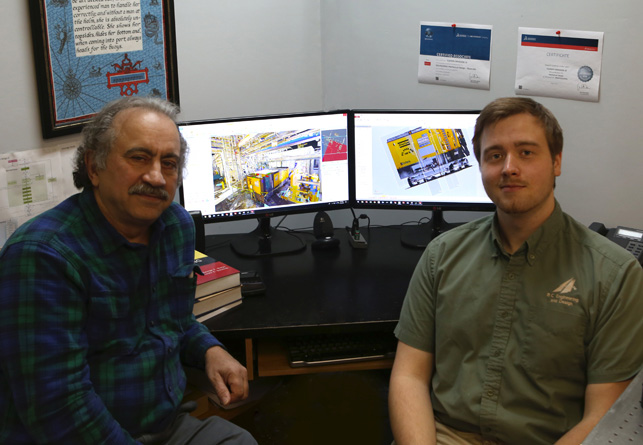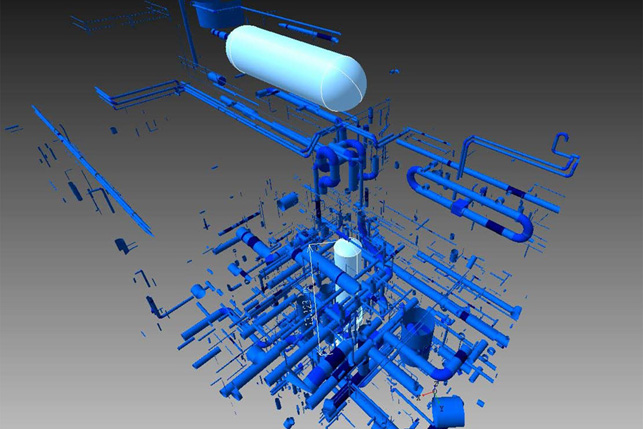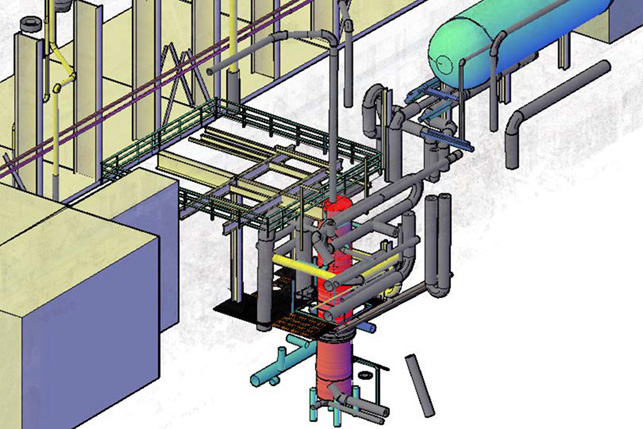
Exterior scan of the Curtis Wright hanger at Hamilton-Owens Airport in Columbia, South Carolina
Anyone who has ever measured their home in preparation for the delivery of a new piano or sofa can appreciate the challenges involved: how will the item get through the door, squeeze around corners in passageways and scale to the room and its other contents?
Now imagine measuring a huge piece of industrial equipment the size of a tractor trailer, which connects to a highway of plumbing and electrical cables. The task of installing it might seem insurmountable.
It’s this kind of challenge that Brian Christiano faces all the time in his role as president of BC Engineering and Design, based in Columbia, South Carolina. Except Christiano isn’t measuring domestic furniture.
His job is more difficult, the stakes far higher and the customers more demanding when a typical project he might undertake is compared to a run-of-the-mill home makeover. BC Engineering specialises in BIM-based [Building Information Management] services, providing valuable help to clients who are planning, designing and managing industrial construction projects and infrastructure renovations.
BC Engineering – Retrofitting Trident
Take, for example, an early BC Engineering project, more than twenty years ago: it involved assisting on the retrofit of Trident submarines – familiar territory for Christiano, who served in the US Navy’s submarine force for more than two decades.
On that project, Christiano mapped out the ship’s communications room by manually measuring the various surfaces and then modelling them in 3D space.
That in itself was pretty innovative at that time. “Back then, everyone was using 2D design software, and a lot of the work was still being done on spreadsheets and pocket calculators,” he says.
“But at one point, I saw a demonstration of 3D solid modelling and finite element analysis software and immediately realised that it was the way of the future.”
It wasn’t long before he took the next step, swapping his plumb bob and tape measure for a laser scanner.
The company quickly became known for its expertise in virtual modelling and finite element analysis, reverse engineering, machine design and more recently, aerial drone inspection services.
The company’s completed project list is now extensive. It has scanned the Church Brew Works in Pittsburgh, South Carolina’s Litchfield Plantation Home dating back to 1740, the Columbia Canal Power Station and the Curtis Wright Hangar at Owens Field, where Christiano can be found flying his own airplane at weekends.
In each of these cases, and hundreds of other projects, he and his team took dozens of images from which building structures were digitally reconstructed.

Brian Christiano (left), president of BC Engineering and Design, and Tommy Maddox (right), the company’s engineering team leader
BC Engineering – Scanning a space
This is how projects begin, with Christiano and his team scanning a space with a portable 3D laser scanner. Within minutes or hours, depending on the size of that space, a beam of laser light will have been bounced off pretty much every surface and object in it, digitising the exact location of each one.
That’s when the hard work begins. For all their high-tech capabilities, laser scanners only provide a point cloud – a massive collection of data that needs to be modified and refined to produce a coherent, 3D model of the scanned structure’s interior and all that it contains.
That’s no easy task and even though laser scanning makes it relatively easy to collect millions or even billions of data points that can be used to describe an object in three-dimensional space, efficient processing of that data is vital to the profit margin and client cost associated with a particular project.
In BC Engineering’s case, an elaborate workflow developed over the years to turn point clouds into usable 3D models. It started with the export of raw data from the laser scanner, verifying its accuracy and then slicing the point cloud at various locations and extruding the cross-sectional profiles of pipes, beams, walls, and other objects found inside the space.
Six separate software packages were required, along with plenty of manual intervention by the CAD operator to determine what was what in the point cloud. Hundreds of hours were spent tying virtual structures together, filling in gaps between architectural members and reconstructing ghostly walls, floors and ceilings.
To complicate matters, several of the software packages used were slow, unreliable and prone to crashes, causing vast amounts of rework – not to mention employee frustration. Software upgrades across multiple platforms were difficult, often resulting in incompatibility between different systems. Some improvements were seen when the scanner manufacturer released a software version with ‘smart look-ahead’ capabilities to automate part of the workflow, but the process was still nowhere close to ideal.
BC Engineering – Taking a new path
The situation came to a head when Christiano realised that this cumbersome methodology was causing the company to miss out on new opportunities.
“We weren’t necessarily happy with our old way of doing things, but it did get the job done,” he says. “And then a potential client called to ask if we could do a travel-path analysis for a large heat exchanger that they were replacing.
This meant scanning the equipment and its surroundings and determining the best route for the riggers to take when removing the old exchanger from the space. Long story short, the other company could do it and we couldn’t. That’s when we started evaluating InfiPoints.”
InfiPoints is a point cloud utilisation tool from Elysium, a software provider based in Southfield, Michigan. It offers data import, pre-processing and analysis, CAD modelling and a host of other functions that were to prove valuable to BC Engineering and Design.
These include ‘fly-through’ capabilities that enable users to take virtual tours of a site before construction begins; automatic mesh generation and feature recognition; noise reduction (for removing people and other moving objects found in the point cloud); and real-time collaboration tools. It also provides the travel path calculations that Christiano and his team needed.
“In the case of the power plant job, the heat exchanger was roughly four stories tall and 18 feet in diameter,” Christiano explains. “It was not only a matter of cutting it and removing it, but they had to figure out if the floors needed to be reinforced, how much the cranes had to lift and then model everything on the 35-year old exchanger itself, so a new one could be built to fit the existing space.”
If BC Engineering had been using InfiPoints when it bid for that contract, it could have virtually rotated any object, laid it down, twisted and turned it however they needed to, with the software identifying any impingement on a defined clearance envelope.
“I’ve since called the owner of that company and told him that, when the next job comes up, we can handle the entire package,” Christiano says. “InfiPoints has brought us to an entirely new playing field.”

Automatic data point registration and bundled adjustments of scan positions of this pumping station with piping and supports took only eight minutes in InfiPoints

With one of BC Engineering’s legacy CAD tools, modelling this power plant feedwater heat exchanger took more than 400 hours

InfiPoints extracted the relevant data in 19 minutes, leaving engineers with little more than minor clean-up work to do
Streamlining the scans
It’s not just about additional functionality, though. Infipoints has also dramatically increased efficiency at BC Engineering and for engineering team leader Tommy Maddox and his group, it’s been a game changer.
“The automatic feature extraction has been one of the biggest improvements for us,” Maddox says. “Before, you could literally spend weeks, and in some cases months, on the legacy software, modelling each element in space, one at a time. With InfiPoints, all of the available elements are extracted automatically in less than an hour, and we can get to detailed modelling right off the bat. It’s made a nightand-day difference to our throughput.”
A recent example of this is BC Engineering’s work on a paper mill project. Because a 10-inch diameter pipe used by the mill had a black matte finish, the laser scanner was unable to pick up certain areas. This resulted in the legacy software being unable to recognize it as pipe, requiring the engineer to manually draw each length.
InfiPoints, however, was able to extract the pipe with ease, as well as the surrounding conduit, railings, electrical boxes, walls and floor, saving the team countless hours of modelling effort.
“The pipe in that example cost $500 a foot, so buying the correct amount was a big concern for our customer,” Christiano explains.
“The plant was so old and the pipe so corroded that they weren’t sure how much they would need. We went out, spent a couple days scanning the entire plant, and were quickly able to give them accurate numbers. Not only that, but we provided a 3D model with all the valves, flanges and fittings, as well as a 2D pipe layout that they’d never had before.” The client was very pleased with the results, he adds.
Worth upsetting the apple cart
As previously mentioned, InfiPoints has allowed the team at BC Engineering to drastically simplify workflows. Six separate software packages have been reduced to two, and in some cases, InfiPoints handles entire jobs on its own.
Considering the additional functionality the company has gained, BC Engineering estimates that a further three software packages would have been required to achieve the same range of functionality on the old set-up.
From an IT perspective, the company no longer needs to manage multiple software packages, labour and software maintenance costs are reduced, training time for each new release is shorter and, best of all, employees are not experiencing work-disrupting computer crashes.
“We save time, we save money, we can tackle bigger projects, we have a lot of extra capabilities and we eliminated a huge number of headaches,” says Maddox.
“For a while, we were getting eight to ten crashes a day, no matter how much computer hardware you threw at the problem. That’s pretty awful for employee morale, never mind the lost productivity. If you’re doing BIM work like we are, you should definitely be using state-of-the-art software.”
Christiano agrees. “InfiPoints allows us to import from our scanning system, or from scans provided to us by others, without any additional tools. We can export to any number of CAD packages. We can do travel paths and fly-through videography and collaborate better with our customers.
We were unable to do any of that before. All that, and there are no more surprises. When you’re in business for yourself, you must think long and hard before upsetting the apple cart, but this is one instance where I’m very glad I did.”

With InfiPoint’s import/export capabilities, CAD to point cloud and point cloud to CAD comparisons are easily performed






